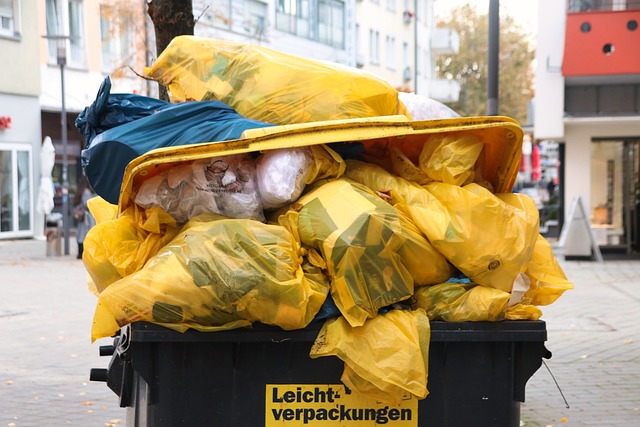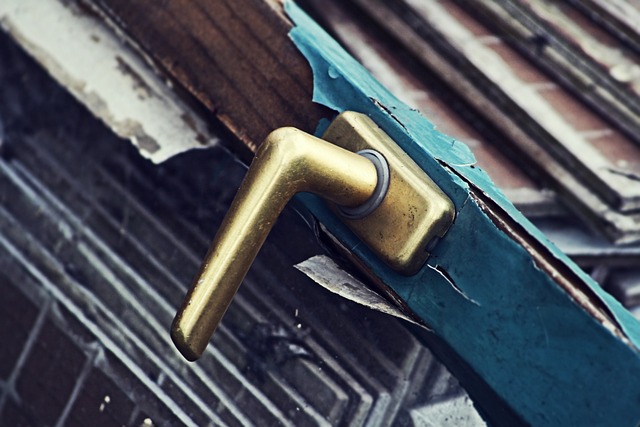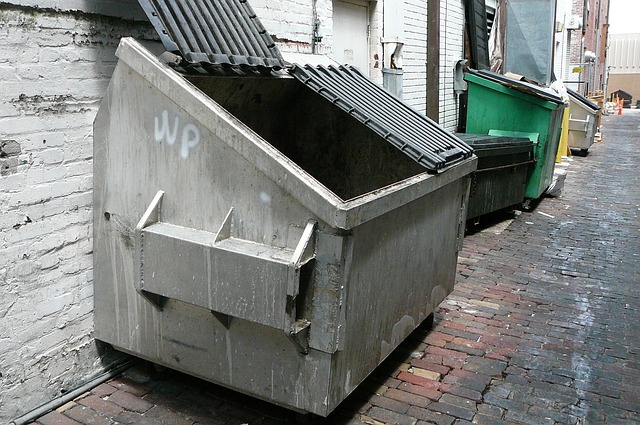The Queens Historic District Renovation Cleanup Dumpsters are integral to the careful restoration of the district's architectural heritage, adhering to strict preservation guidelines due to its historical significance. Specialized cleaning services tailor solutions for unique cleanup challenges, ensuring compliance with local regulations and minimizing environmental impact while maintaining the district's integrity during renovations. These dumpsters are strategically placed to manage waste without disrupting the historic atmosphere, allowing property owners to efficiently manage their projects in alignment with both preservation standards and timelines. The waste management process involves careful planning considering the scope of projects, local regulations, and environmental considerations, ensuring that historical materials are repurposed or recycled responsibly. Coordination with environmental agencies is crucial for adhering to historical preservation standards and eco-friendly practices. This thoughtful approach not only safeguards the district's legacy but also promotes a sustainable future, making the Queens Historic District Renovation Cleanup an exemplary model of preservation and sustainability within historic districts.
Queens Historic District Renovation Cleanup presents unique challenges that necessitate specialized services to maintain the area’s historical integrity while ensuring modern efficiency. This article delves into the intricate process, from navigating renovation cleanup nuances to implementing eco-conscious waste management and employing advanced cleaning techniques. We explore the pivotal role of dumpsters in large-scale historical restorations, the importance of understanding local regulations for dumpster use within historic districts, and share insights through case studies that highlight successful renovation efforts in Queens. Join us as we shed light on this delicate balance between preservation and progress.
- Navigating the Nuances of Queens Historic District Renovation Cleanup
- The Role of Dumpsters in Facilitating Large-Scale Historical Renovations
- Eco-Friendly Waste Management Options for Historic District Restorations
- Specialized Cleaning Techniques Preserving the Integrity of Queens Landmarks
- Understanding Local Regulations and Permits for Renovation Dumpster Use in Historic Districts
- Case Studies: Successful Queens Historic District Renovations and Their Cleanup Efforts
Navigating the Nuances of Queens Historic District Renovation Cleanup

Queens Historic District, with its rich tapestry of architectural heritage, presents unique challenges for renovation projects. Contractors and homeowners undertaking such endeavors must adhere to stringent guidelines to preserve the area’s historical integrity. A critical aspect of these renovations is the cleanup process, which demands a specialized approach due to the sensitive nature of the district. The Queens Historic District Renovation Cleanup requires meticulous attention to detail, as debris and materials must be carefully sorted and disposed of in accordance with local regulations. To manage this efficiently, specialized cleaning services offer solutions tailored to the historic context. These services provide ample-sized dumpsters that are strategically placed to accommodate the volume of waste generated without disrupting the historical ambiance. This ensures compliance with the district’s guidelines and facilitates a seamless renovation process. By partnering with these experts, property owners can navigate the complexities of cleanup within the historic district effectively, upholding both the character of the area and the timeline of their renovation projects.
The Role of Dumpsters in Facilitating Large-Scale Historical Renovations

Throughout the course of a large-scale historical renovation, such as those within the Queens Historic District, the logistical aspects of waste management play a pivotal role in both the efficiency and environmental safety of the project. Dumpsters serve as critical components in this process by providing a reliable means for contractors to dispose of vast quantities of debris generated from renovation work. These containers are strategically placed to accommodate the bulk of construction waste, ranging from aged materials to be repurposed or recycled to modern building offcuts. The presence of ample dumpster capacity ensures that historical structures undergoing restoration can do so without compromising the surrounding environment or public spaces.
The selection and placement of dumpsters for a project like the Queens Historic District Renovation Cleanup are not undertaken haphazardly. It requires careful planning to determine the appropriate size and number of dumpsters needed, considering factors such as the scope of work, timelines, and local regulations. Additionally, coordination with environmental agencies is essential to ensure that the disposal methods align with historical preservation standards and eco-friendly practices. This meticulous approach not only aids in maintaining the integrity of the historic district but also contributes to the sustainability of the renovation process as a whole.
Eco-Friendly Waste Management Options for Historic District Restorations

Queens Historic District renovations necessitate specialized attention to detail, particularly when it comes to waste management. Contractors and restorers working on these landmarked properties must adhere to eco-friendly practices to preserve the integrity of the historic architecture while ensuring environmental stewardship. Eco-conscious cleanup solutions are paramount, with dumpsters designed for the responsible disposal of materials. These specialized containers are not only tailored to handle the unique debris generated by such renovations but also facilitate recycling and composting initiatives, minimizing the ecological footprint of the project. Partnerships with local waste management companies that specialize in handling historic district renovation waste ensure that materials are sorted and repurposed whenever possible, adhering to both historical preservation standards and modern sustainability goals. This approach not only respects the past but also invests in a greener future for the community at large.
Specialized Cleaning Techniques Preserving the Integrity of Queens Landmarks

Queens Historic District, encompassing a rich mosaic of architectural styles and historical significance, demands specialized cleaning techniques that preserve its integrity. Renovation and cleanup efforts within this landmarked area necessitate an approach that balances modern maintenance with the preservation of its original charm. Contractors and cleaning crews employed in these endeavors utilize eco-friendly products and gentle methods to ensure the structural and aesthetic integrity of these treasured sites remain intact. The use of dumpsters strategically placed within the district facilitates the efficient removal of debris, maintaining the area’s aesthetic appeal while supporting the renewal process. This thoughtful integration of renovation and cleanup services not only revitalizes these historical landmarks but also honors their legacy for future generations to appreciate. The specialized techniques, incorporating dust collection systems, biohazard waste disposal protocols, and historic material handling guidelines, are pivotal in maintaining the authenticity and grandeur of Queens Historic District’s iconic buildings.
Understanding Local Regulations and Permits for Renovation Dumpster Use in Historic Districts

When undertaking renovation projects within the Queens Historic District, it is imperative to be well-versed in the local regulations and permit requirements for utilizing renovation cleanup dumpsters. These historic districts are often governed by stringent guidelines designed to preserve their cultural and architectural integrity. Homeowners and contractors must navigate the specific regulations that dictate how renovations can be conducted, ensuring compliance with standards that protect the district’s historical character. This includes obtaining the necessary permits from local authorities, such as the New York City Landmarks Preservation Commission, which oversee the preservation of these areas.
Understanding the nuances of these regulations is crucial for a smooth renovation process. Dumpsters placed within the historic district must blend with the surroundings or be screened to maintain the visual integrity of the neighborhood. Additionally, the size and placement of dumpsters are subject to approval by the local historical preservation office. Contractors must also consider the timing and duration of dumpster use, as these can be restricted in historic districts due to their impact on the area’s aesthetic value. By adhering to these guidelines and securing the appropriate permits, renovation projects can proceed efficiently while respecting the heritage of the Queens Historic District. This due diligence not only ensures legal compliance but also contributes to the ongoing preservation efforts that protect these valuable historical areas for future generations.
Case Studies: Successful Queens Historic District Renovations and Their Cleanup Efforts

The Queens Historic District in New York, a treasure trove of architectural heritage, has undergone significant renovations that highlight the importance of preserving history while ensuring modern living standards. These restoration projects often necessitate the removal of debris and waste materials, which are efficiently managed through the use of dumpsters specifically designed for historic district environments. For instance, during the restoration of a Victorian-era brownstone, specialized cleaning services provided ample dumpsters to accommodate the various waste streams generated from lead paint abatement to selective demolition. The cleanup efforts were not only crucial for maintaining the district’s aesthetic integrity but also ensured compliance with environmental regulations. Another successful renovation involved a row of early 20th-century storefronts. Here, the cleanup crews implemented a waste management plan that categorized and disposed of materials accordingly, from asbestos-laden insulation to discarded construction materials. This meticulous approach not only streamlined the renovation process but also minimized the environmental impact, showcasing the effectiveness of Queens Historic District renovation cleanup efforts with dumpsters playing a pivotal role in waste management strategies.
In conclusion, the meticulous restoration of Queens Historic District stands as a testament to the enduring legacy and architectural splendor of its past. The renovation cleanup process, which encompasses specialized cleaning techniques, adherence to local regulations, and the strategic deployment of dumpsters for waste management, is a critical component in preserving these landmarks for future generations. Eco-friendly practices ensure that the environmental impact is minimized while upholding the integrity of these historic sites. Through careful planning and respectful restoration efforts, Queens Historic District renovations exemplify a harmonious blend of reverence for history and modern conservation methods. Contractors and historians alike recognize the importance of such undertakings to maintain the vibrancy and significance of these structures within the community.
